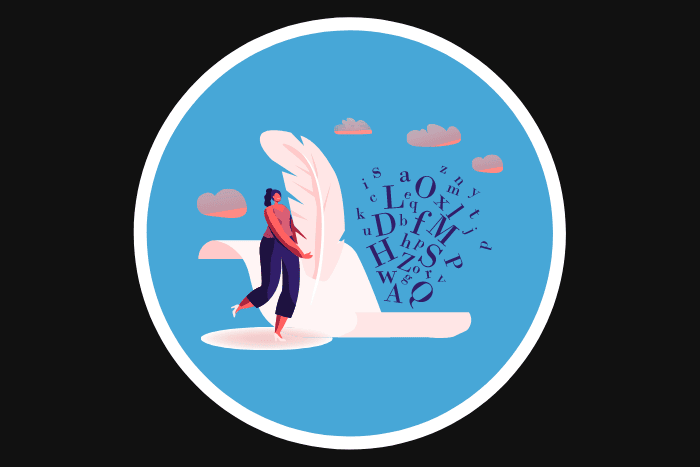Maybe you’re a playwright or screenwriter, and you want to craft a soliloquy for one of your characters.
Or if you’re like me, you’re just curious about literary terms and love to learn about them.
Either way, it’s easy to feel mystified about what a soliloquy is.
And some people confuse this literary device with a monologue (it’s different).
But in this post, we’re going to explain exactly what you need to know.
Plus, we’ll run through 10 examples of highly effective soliloquies.
Let’s do this.

What is a Soliloquy?
Soliloquy Definition: A soliloquy is a speech that a character delivers unheard by any other characters.
You’ll most commonly come across them in plays, particularly in Shakespeare’s works and other Elizabethan plays. But you can also find examples of this literary device in much more modern drama.
A soliloquy isn’t necessarily a long speech, but it should be more than just a sentence or two.
Types of Soliloquy
Soliloquies are categories in many ways. One way to divide them up is into three key types based on who the character is talking to:
To Themselves
This type of literary term is the most common. A character is thinking out loud, talking to an empty room. It’s the characters inner thoughts — the equivalent of a first-person narrator’s story in written fiction. Most soliloquies take this form.
To An Object
Sometimes, a soliloquy is delivered to an object of some kind — or even a pet. It might even be to a corpse. If the character is talking to something or someone who can’t hear and respond, then it’s still a soliloquy.
To The Audience
Sometimes, a character will “break the fourth wall” and speak directly to the target audience. It’s similar to an aside, but longer.
10 Examples of Soliloquy
The easiest way to understand soliloquy is to take a look at some examples. We’ve picked 10 great ones to study, from ancient Greece to modern-day TV shows.
Examples of Soliloquy in Literature

1. Faustus’ Final Soliloquy, Doctor Faustus, by Christopher Marlowe (1592)
FAUSTUS: Ah, Faustus.
Now hast thou but one bare hour to live,
And then thou must be damned perpetually!
Stand still, you ever-moving spheres of heaven,
That time may cease, and midnight never come;
Fair Nature’s eye, rise, rise again, and make
Perpetual day; or let this hour be but
A year, a month, a week, a natural day,
That Faustus may repent and save his soul!
(You can read the rest of the soliloquy here.)
In this example, Faustus, having sold his soul to the devil in exchange for power and knowledge, is an hour away from being damned. His desperate soliloquy is the climax of the play.
2. Tom’s Soliloquy, The Glass Menagerie, Tennessee Williams (1944)
TOM: I descended the steps of this fire escape for a last time and followed, from then on, in my father’s footsteps, attempting to find in motion what was lost in space. . . . I would have stopped, but I was pursued by something. . . . I pass the lighted window of a shop where perfume is sold. The window is filled with pieces of colored glass, tiny transparent bottles in delicate colors, like bits of a shattered rainbow.
Tom’s soliloquy (which goes on for a few more lines after this) ends the play. He imagines he’s talking to his sister, Laura, but she’s inside and can’t hear him.
3. Agamemnon, by Aeschylus (458 BC)
I pray the gods to quit me of my toils,
To close the watch I keep, this livelong year;
For as a watch-dog lying, not at rest,
Propped on one arm, upon the palace-roof
Of Atreus’ race, too long, too well I know
The starry conclave of the midnight sky,
Too well, the splendours of the firmament,
The lords of light, whose kingly aspect shows-
What time they set or climb the sky in turn-
The year’s divisions, bringing frost or fire.
(You can read the rest of the soliloquy here.)
Unlike the previous two examples, this soliloquy doesn’t come at the end of the play. Instead, it forms the opening lines, setting the scene for what’s to come, as a tired watchman laments his tedious work.
Examples of Soliloquy from Shakespeare

Shakespeare has multiple soliloquies throughout his plays, particularly in the tragedies. Here are some of the most notable and famous soliloquy examples.
4. The “To Be or Not To Be” Speech, Hamlet, William Shakespeare (1609)
To be, or not to be, that is the question:
Whether ’tis nobler in the mind to suffer
The slings and arrows of outrageous fortune,
Or to take arms against a sea of troubles
And by opposing end them. To die – to sleep,
No more; and by a sleep to say we end
The heart-ache and the thousand natural shocks
That flesh is heir to: ’tis a consummation
Devoutly to be wish’d. To die, to sleep;
To sleep, perchance to dream – ay, there’s the rub…
(You can read the rest of the soliloquy here.)
Prince Hamlet’s famous soliloquy reflects, through a number of metaphors, on whether it’s better to be alive or dead.
5. Iago’s Soliloquy in Act 3 scene 3, Othello, William Shakespeare
I will in Cassio’s lodging lose this napkin,
And let him find it. Trifles light as air
Are to the jealous confirmations strong
As proofs of holy writ. This may do something.
The Moor already changes with my poison.
(You can read the rest of this soliloquy in context here.)
Iago’s soliloquy, like several of his other soliloquies in Othello, lets the audience know what he’s planning and why.
6. “Is This a Dagger Which I See Before Me?” Speech, Macbeth, William Shakespeare (1606)
Is this a dagger which I see before me,
The handle toward my hand? Come, let me clutch thee.
I have thee not, and yet I see thee still.
Art thou not, fatal vision, sensible
To feeling as to sight? or art thou but
A dagger of the mind, a false creation,
Proceeding from the heat-oppressed brain?
Macbeth, torn about whether he should murder King Duncan, in order to be crowned King of Scotland himself, hallucinates a dagger in front of him.
7. Romeo and Juliet’s soliloquies, Act 5, scene 3, Romeo and Juliet, William Shakespeare (1597)
… Eyes, look your last!
Arms, take your last embrace! and, lips, O you
The doors of breath, seal with a righteous kiss
A dateless bargain to engrossing death!
Come, bitter conduct, come, unsavoury guide!
Thou desperate pilot, now at once run on
The dashing rocks thy sea-sick weary bark!
Here’s to my love!
[Drinks]
(You can read the rest of the scene here.)
Both Romeo and Juliet give soliloquies in this scene set in the Capulets’ family tomb. Here, they explain their feelings and actions (Romeo poisons himself, thinking Juliet dead; she comes round, sees him dead, and stabs herself).
Common Examples of Soliloquy in Pop Culture

While soliloquy isn’t generally used in such a formal, extensive way today, you can still find soliloquies and near-soliloquies in popular TV shows and films from more recent years.
8. Raoul Duke, Fear and Loathing in Las Vegas (1998)
How long could we maintain? I wondered. How long until one of us starts raving and jabbering at this boy? What will he think then? This same lonely desert was the last known home of the Manson family; will he make that grim connection when my attorney starts screaming about bats and huge manta rays coming down on the car?
The 1998 film Fear and Loathing in Las Vegas, based on Hunter S Thompson’s 1971 novel, includes a lot of voice-over narration from Raoul Duke, played by Johnny Depp.
Watch the clip here:
9. The “You Talkin’ To Me?” speak, Taxi Driver (1976)
“You talkin’ to me? You talkin’ to me? You talkin’ to me? Well, who the hell else are you talkin’ to? You talkin’ to me? Well, I’m the only one here. Who the f–k do you think you’re talkin’ to? Oh yeah? Huh?”
In this example, Travis Bickle, played by Robert De Niro, talks to himself at length in a mirror, imagining a confrontation as he points his gun at his reflection.
Watch the clip for yourself:
10. Dexter Morgan’s soliloquies, Dexter (2006 – 2013)
Every Saturday, beginning dive classes practice underwater skills beside this dock. Tomorrow, they’ll find a morbid little surprise. When the Feds receive these kill tools with their suspect’s prints on them, the only threat to me will be the inane rants of a murderous madman. So close, I can feel it.
Dexter is a serial killer who targets serial killers. He hides who he is from other characters, but reveals his true innermost thoughts and feelings to the audience.
Watch Dexter’s chilling soliloquy here:
Related Terms: Monologue, Aside, Lampshading
Some other literary terms and dramatic devices related to soliloquy include monologue, aside, and lampshading.
What do these mean?
Monologue
A monologue is a moving speech delivered by one character. Soliloquies are types of monologue — but unlike a soliloquy, a monologue can be delivered to another character (and often is). Make sure you distinguish between soliloquy vs monologue and don’t use the terms synonymously.
Aside
An aside is a short comment that other characters don’t hear. It’s as though the character is talking briefly to themself — or even directly to the audience. You could think of it as a very short soliloquy.
Lampshading
Lampshading, or “lampshade hanging”, is when a character draws attention to something unrealistic or hard to believe in the plot. If a character says something like, “If I saw this on TV, I’d never believe it,” that’s lampshading.
Why Do Writers Use Soliloquies?
Soliloquies give scriptwriters and screenwriters a chance to show the audience what’s going on inside a character’s mind. They can help to:
- Give the audience necessary information about what the character is doing and why, if this isn’t clear from the action and dialogue.
- Show that a character is hiding something.
- Give insight into the character’s unusual state of mind — whether that’s madness, being very drunk or high, falling in love, or something else where their inner thought or feeling is unusual.
- Set the scene for the story or foreshadow events to come. A soliloquy or chorus at the start of a play can fill this role.
- Create dramatic irony by revealing the characters inner thoughts. For instance, Iago telling the audience about his plotting means we see him in his true colors — and pity Othello, who’s completely taken in.
Related Reading: 20 Aphorism Examples that Prove Knowledge is Power
Use These Soliloquy Examples to Develop Your Own Understanding
Whether you’re entering a writing contest, looking for writing inspiration, or just want a better understanding of why and how soliloquies are used, the examples above are all great ones to learn from.
You might want to watch clips of them in action to see how they work alongside visual narration. For some of the longer soliloquies, such as the Shakespearean ones, I recommend reading the whole thing.
Still not 100% sure on whether a particular quote is a soliloquy or not? None of these soliloquy examples are spoken to another character. If another character is listening, it’s a monologue.







